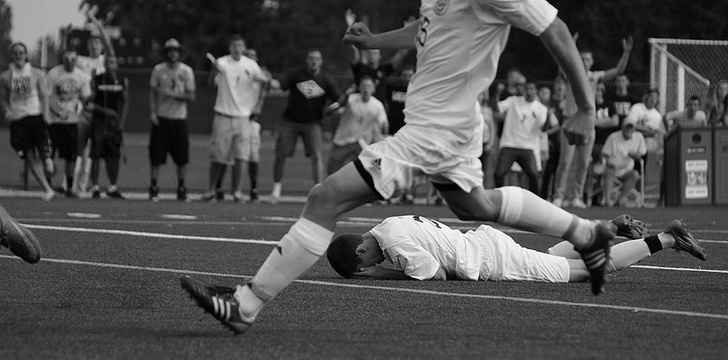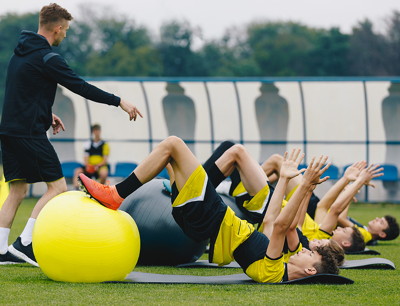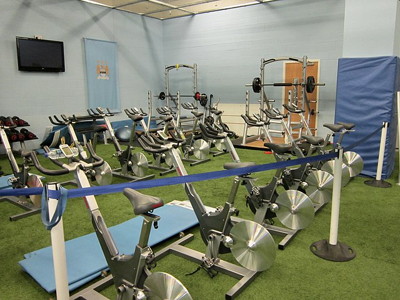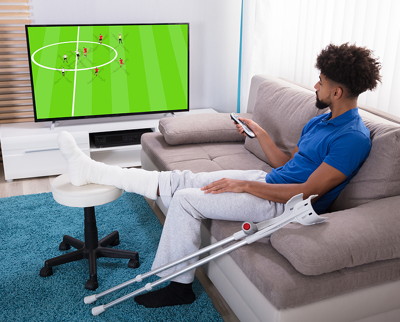 We could write a piece entirely about the injury table present at most football clubs, such is the extent to which they have a rich and storied history.
We could write a piece entirely about the injury table present at most football clubs, such is the extent to which they have a rich and storied history.
There was a story at Anfield, perhaps apocryphal, that every player to have played for Liverpool had signed the treatment table in the dressing room, only for Graeme Souness to order its removal when he took over as manager of the club, for example. Instead of looking at that, however, we’re going to take a wider and more broad look at players in general and the injuries that they suffer.
When a player gets hit with a long-term injury, what exactly do they get up to? Football fans obviously want them back and playing as soon as possible, but clubs need to ensure that they’re as close to full fitness as possible before asking them to get out onto the pitch and possible do themselves further damage.
There are any numbers of stories of players who were forced to get back onto the pitch sooner than they should have been, thereby exacerbating their injury and ending up curtailing their career. What happens when a player gets injured and the club want to get things right?
How Bad Is The Injury?

Understandably, the most important factor when considering what a player might get up to whilst injured is how bad their injury actually is. A sprained ankle will be painful, for example, but nowhere near as lengthy to recover from as an ACL injury.
It is little wonder, therefore, that physios want to get information about a player’s injury as soon as possible. If you’ve ever watched a match in which a player suffers a bad injury, you’ll often hear that they’ve been taken to a hospital and given a scan before the referee has even blown the full-time whistle.
Sometimes, rushing a player for a scan will do no good, with the need to wait until the swelling has gone down paramount in any diagnosis. The club’s physiotherapist and doctor will work together with specialists to determine what damage a player has suffered, figuring out exactly what their injury is and what can be done to get them back on track.
Nowadays, medical professionals have a wealth of information that allows them to figure out exactly how badly injured a player is, as well as what needs to be done to aid their recovery.
What Happens Next?
 Once the extent of an injury has been discovered, the next thing that will happen is that the club physio will work with the medical team to come up with a plan of recovery. Initially, what they can and can’t do will depend entirely on what the injury actually is. As an example of what we’re talking about, one need only look to the Anterior Cruciate Ligament injury suffered by Chelsea’s Kurt Zouma back in 2016. The injury was severe enough to rule him out for the better part of a year, but the manager still took him on the club’s pre-season tour of the United States of America.
Once the extent of an injury has been discovered, the next thing that will happen is that the club physio will work with the medical team to come up with a plan of recovery. Initially, what they can and can’t do will depend entirely on what the injury actually is. As an example of what we’re talking about, one need only look to the Anterior Cruciate Ligament injury suffered by Chelsea’s Kurt Zouma back in 2016. The injury was severe enough to rule him out for the better part of a year, but the manager still took him on the club’s pre-season tour of the United States of America.
This was because Antonio Conte was relatively new in the job at Stamford Bridge and knew that he would be doing a lot of tactical training sessions that wouldn’t require the player to actually have to kick the ball. Zouma was seen as an important player for Chelsea at the time, so the manager wanted to ensure that he was up to speed as soon as he returned from his injury and could therefore get right back into playing. That move was also considered to be important for the player’s mental health, which is often forgotten about during long-term injuries.
It is somewhat inevitable that players that suffer bad injuries will feel as though they’re separate from their team-mates. The very nature of injuries means that they will need to do specific work aimed at getting them back to full fitness as soon as possible. A lot of managers don’t like to have injured players around the full-fit ones, feeling that it can bring a bad vibe to training and make players think twice before making 50-50 challenges or the likes. It is just as important for clubs to help players deal with the loneliness that comes with injury.
Realistic Targets
 When a player is coming back from a serious injury, it is typical for the medical team to give them realistic targets. The one thing that no one wants to do is have a player that is feeling despondent because they have not reached the target that was set for them.
When a player is coming back from a serious injury, it is typical for the medical team to give them realistic targets. The one thing that no one wants to do is have a player that is feeling despondent because they have not reached the target that was set for them.
Hitting the targets, however slowly and regardless of how small they are, can provide players with a sense of accomplishment and as though they are genuinely getting better. Doing something like walking a bit further than before or bending a leg further than they had previous is a genuine achievement.
This has changed markedly from years gone by. Brian Clough, for example, famously used to ignore his injured players as he deemed them ‘worthless’ to the club. Nowadays, the money involved in football is such that clubs can’t simply ignore a player.
Whether they want to get them fit enough to be sold or they want to bring them back into the first-team, a player needs to be treated well on their road to recovery. They work with strength and conditioning coaches to get strength back into the injured limb, as well as with dieticians to ensure that they don’t put on too much weight whilst unable to exercise.
Stepping It Up In The Gym

As a player’s recover continues, work will be done to step up their progress in the gym. There will be a focus on strengthening the injured area in order to ensure that it can take more and more weight.
The development of technology has been a big help in getting injured players back playing, not least of all because surgeons can watch videos of an injury to determine the best way forward within hours of it happening. There is also the fact that things like anti-gravity treadmills exist, letting players exercise without putting too much strain on the muscle or joint.
Whilst supporters have no idea what it is that is going on behind the scenes, players’ days are full thanks to the intensity of the fitness regime. Whether it be gym-based work, swimming or even the use of electrical stimulators on muscles, there is a huge amount going on to get the player fit.
Once they can head outdoors to train properly, GPS information is used to monitor their regular improvements. Even weaknesses can be worked on, thanks to the information gleamed from the machines and monitors used by experts.
The Players Need To Feel Comfortable
 It goes without saying that the work of the medical team is the most important in a player’s recovery, but the players themselves need to be comfortable with what they’re being asked to do.
It goes without saying that the work of the medical team is the most important in a player’s recovery, but the players themselves need to be comfortable with what they’re being asked to do.
It is not uncommon for players just returning from injury to be wary of going into tackles, for example, such is there a fear that they will re-injure themselves and have to go through all of the work again. It is why many players resist the call to go back into the starting eleven too quickly, regardless of how important the manager deems them to be.
In the past, players have simply been given pain-killing injections and told to get on with it. Nowadays, that sort of approach is largely frowned upon by the medical experts.
Teams try to show a togetherness for injured players, as demonstrated by Manchester City when Ilkay Gündogan suffered a long-term injury in 2017. Plans are put in place to get them onto the pitch as soon as it is safe for them to do so, without pushing them too far too quickly. That doesn’t necessarily mean that they’ll be mentally ready, but the medical team will have done all that it can to ensure that they are.
Payment For Players
 One of the interesting things about players and injuries comes in the form of what happens to their payments. Nowadays, even the most lowly of Premier League players will be on tens of thousands of pounds a week, so do they just have to live with what they’ve got when they pick up an injury? Obviously it depends on the club, the player and the contract that they’ve signed, but generally speaking players in England are entitled to full-pay for 18 months, presuming that they suffered the injury whilst playing for the club.
One of the interesting things about players and injuries comes in the form of what happens to their payments. Nowadays, even the most lowly of Premier League players will be on tens of thousands of pounds a week, so do they just have to live with what they’ve got when they pick up an injury? Obviously it depends on the club, the player and the contract that they’ve signed, but generally speaking players in England are entitled to full-pay for 18 months, presuming that they suffered the injury whilst playing for the club.
If a player is injury because of something that they’ve done at home or whilst away on international duty, there is a chance that they will only be paid their full wage for a year. At this point, clubs can theoretically look at cutting their wage in half or reducing it in some other way. It is difficult for most clubs to do this, however, given the extent to which they claim to be ‘families’. Clubs try to not antagonise their players if they can help it, instead treating them with respect and paying them for the length of their injury.
It is not exactly unheard of for players to buy insurance in order to ensure that they will still be paid if they’re injured for a long time. In Germany, for example, a club is only contractually obliged to pay a player’s wage for six weeks, compared to three months in France and six months in Italy. Holland is the exception to the rule in Europe, with clubs paying a player’s contract for the length of the injury, even if it looks like it might be a career-ending one. This compared favourable to the 18 months that a Spanish player will be paid their basic salary.
Football clubs tend to have insurances in place in order to avoid having to pay large amounts of cash out to injured players. As an example of this, Bolton Wanderers were paid out on their insurance when Fabrice Muamba suffered cardiac arrest on the pitch in 2012. It is hardly surprising that clubs insure their footballers, of course, given that they are one of the most important assets that clubs have on the books. Often, though, it all depends on how and when the player picked up the injury when it comes to who is responsible for paying them.
What Happens When The Injury Is Career-Ending?
 Thankfully, it is decidedly rare for a player to suffer a career-ending injury. The combination of advancements in medical research, improved technologies and the work of medical teams at football grounds mean that footballers are often treated well enough at the stadium before they even go to a hospital. Once there, the work done on the pitch can have saved a huge amount of time, such as Liverpool player Harvey Elliott experience when he suffered an ankle-fracture-dislocation in 2021 and the on-pitch physio put it back into place.
Thankfully, it is decidedly rare for a player to suffer a career-ending injury. The combination of advancements in medical research, improved technologies and the work of medical teams at football grounds mean that footballers are often treated well enough at the stadium before they even go to a hospital. Once there, the work done on the pitch can have saved a huge amount of time, such as Liverpool player Harvey Elliott experience when he suffered an ankle-fracture-dislocation in 2021 and the on-pitch physio put it back into place.
Doing that alleviated major stress on the joint, which allowed surgery to take place quickly and reduced the possible recovery time for the young player. Sadly, though, not all players are as fortune as Elliott. In 2019, Leon Mark McKenzie spoke about how he was forced to retire from football at the age of 33 after tearing his hamstring. This injury came on top of previous ones, such as rupturing his thigh muscle and his Achilles. Having done nothing but play football for all of his life, he had no idea what to do after retirement hit.
In the following weeks, he was ‘drawn into a place of darkness’, feeling embarrassed and vulnerable. He attempted suicide, using his experience in later years to try to help others in a similar situation. In the end, he took up boxing, eventually retiring from that on his own terms at the age of 39. His story was a particularly dark one, but it is similar for players of all ages and the Professional Football Association can only do so much to help. Injuries that players recover from are one thing, but injuries that end careers are something else entirely.
